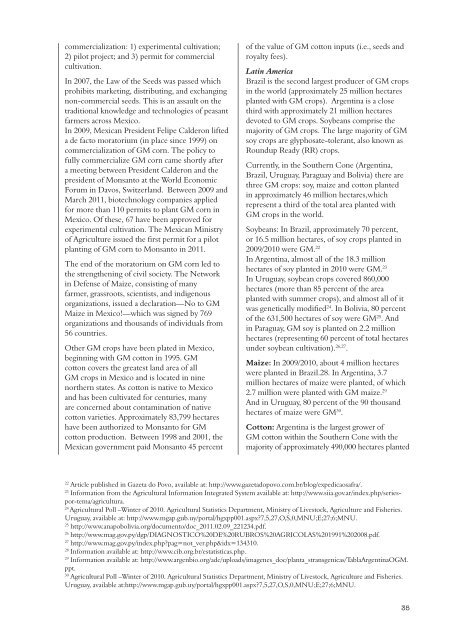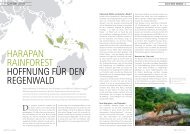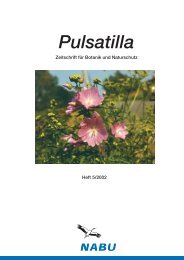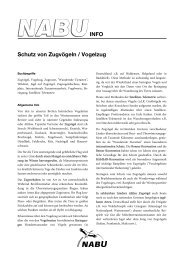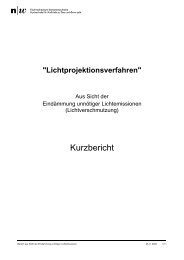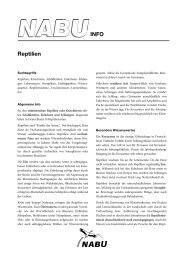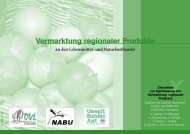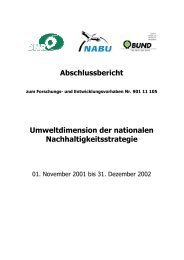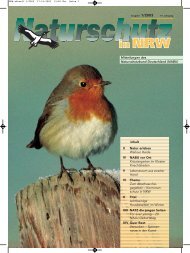Studie "The GMO-emperor has no clothes" (engl.) - Nabu
Studie "The GMO-emperor has no clothes" (engl.) - Nabu
Studie "The GMO-emperor has no clothes" (engl.) - Nabu
Create successful ePaper yourself
Turn your PDF publications into a flip-book with our unique Google optimized e-Paper software.
commercialization: 1) experimental cultivation;<br />
2) pilot project; and 3) permit for commercial<br />
cultivation.<br />
In 2007, the Law of the Seeds was passed which<br />
prohibits marketing, distributing, and exchanging<br />
<strong>no</strong>n-commercial seeds. This is an assault on the<br />
traditional k<strong>no</strong>wledge and tech<strong>no</strong>logies of peasant<br />
farmers across Mexico.<br />
In 2009, Mexican President Felipe Calderon lifted<br />
a de facto moratorium (in place since 1999) on<br />
commercialization of GM corn. <strong>The</strong> policy to<br />
fully commercialize GM corn came shortly after<br />
a meeting between President Calderon and the<br />
president of Monsanto at the World Eco<strong>no</strong>mic<br />
Forum in Davos, Switzerland. Between 2009 and<br />
March 2011, biotech<strong>no</strong>logy companies applied<br />
for more than 110 permits to plant GM corn in<br />
Mexico. Of these, 67 have been approved for<br />
experimental cultivation. <strong>The</strong> Mexican Ministry<br />
of Agriculture issued the first permit for a pilot<br />
planting of GM corn to Monsanto in 2011.<br />
<strong>The</strong> end of the moratorium on GM corn led to<br />
the strengthening of civil society. <strong>The</strong> Network<br />
in Defense of Maize, consisting of many<br />
farmer, grassroots, scientists, and indige<strong>no</strong>us<br />
organizations, issued a declaration—No to GM<br />
Maize in Mexico!—which was signed by 769<br />
organizations and thousands of individuals from<br />
56 countries.<br />
Other GM crops have been plated in Mexico,<br />
beginning with GM cotton in 1995. GM<br />
cotton covers the greatest land area of all<br />
GM crops in Mexico and is located in nine<br />
<strong>no</strong>rthern states. As cotton is native to Mexico<br />
and <strong>has</strong> been cultivated for centuries, many<br />
are concerned about contamination of native<br />
cotton varieties. Approximately 83,799 hectares<br />
have been authorized to Monsanto for GM<br />
cotton production. Between 1998 and 2001, the<br />
Mexican government paid Monsanto 45 percent<br />
of the value of GM cotton inputs (i.e., seeds and<br />
royalty fees).<br />
Latin America<br />
Brazil is the second largest producer of GM crops<br />
in the world (approximately 25 million hectares<br />
planted with GM crops). Argentina is a close<br />
third with approximately 21 million hectares<br />
devoted to GM crops. Soybeans comprise the<br />
majority of GM crops. <strong>The</strong> large majority of GM<br />
soy crops are glyphosate-tolerant, also k<strong>no</strong>wn as<br />
Roundup Ready (RR) crops.<br />
Currently, in the Southern Cone (Argentina,<br />
Brazil, Uruguay, Paraguay and Bolivia) there are<br />
three GM crops: soy, maize and cotton planted<br />
in approximately 46 million hectares,which<br />
represent a third of the total area planted with<br />
GM crops in the world.<br />
Soybeans: In Brazil, approximately 70 percent,<br />
or 16.5 million hectares, of soy crops planted in<br />
2009/2010 were GM. 22<br />
In Argentina, almost all of the 18.3 million<br />
hectares of soy planted in 2010 were GM. 23<br />
In Uruguay, soybean crops covered 860,000<br />
hectares (more than 85 percent of the area<br />
planted with summer crops), and almost all of it<br />
was genetically modified 24 . In Bolivia, 80 percent<br />
of the 631,500 hectares of soy were GM 25 . And<br />
in Paraguay, GM soy is planted on 2.2 million<br />
hectares (representing 60 percent of total hectares<br />
under soybean cultivation). 26,27 .<br />
Maize: In 2009/2010, about 4 million hectares<br />
were planted in Brazil.28. In Argentina, 3.7<br />
million hectares of maize were planted, of which<br />
2.7 million were planted with GM maize. 29<br />
And in Uruguay, 80 percent of the 90 thousand<br />
hectares of maize were GM 30 .<br />
Cotton: Argentina is the largest grower of<br />
GM cotton within the Southern Cone with the<br />
majority of approximately 490,000 hectares planted<br />
22<br />
Article published in Gazeta do Povo, available at: http://www.gazetadopovo.com.br/blog/expedicaosafra/.<br />
23<br />
Information from the Agricultural Information Integrated System available at: http://www.siia.gov.ar/index.php/seriespor-tema/agricultura.<br />
24<br />
Agricultural Poll –Winter of 2010. Agricultural Statistics Department, Ministry of Livestock, Agriculture and Fisheries.<br />
Uruguay, available at: http://www.mgap.gub.uy/portal/hgxpp001.aspx?7,5,27,O,S,0,MNU;E;27;6;MNU.<br />
25<br />
http://www.anapobolivia.org/documento/doc_2011.02.09_221234.pdf.<br />
26<br />
http://www.mag.gov.py/dgp/DIAGNOSTICO%20DE%20RUBROS%20AGRICOLAS%201991%202008.pdf.<br />
27<br />
http://www.mag.gov.py/index.php?pag=<strong>no</strong>t_ver.php&idx=134310.<br />
28<br />
Information available at: http://www.cib.org.br/estatisticas.php.<br />
29<br />
Information available at: http://www.argenbio.org/adc/uploads/imagenes_doc/planta_stransgenicas/TablaArgentinaOGM.<br />
ppt.<br />
30<br />
Agricultural Poll –Winter of 2010. Agricultural Statistics Department, Ministry of Livestock, Agriculture and Fisheries.<br />
Uruguay, available at:http://www.mgap.gub.uy/portal/hgxpp001.aspx?7,5,27,O,S,0,MNU;E;27;6;MNU.<br />
35


